These web pages present the current state of our study, (an alphabetical listing). The species included here are limited to those which 1) specimens exist in one of our collections or specimens we have seen & photoed a convincing specimen, 2) we have one or more photos, and 3) for which in most cases we have an analytic result to support the indicated identification. Many of these species are rare or uncommon in New Hampshire. Frequently only one or two examples are known to exist. Some confirmations are from decades old collections.
I acknowledge the New Hampshire species list on the mindat.org (NH-list) web site has about fifty (2023) additional entries that are not on my NH species list or on this post 2010 list. A review of these will be the topic of a future study.
Some of these rare-uncommon species have been identified with greater confidence than others. To convey this level of confidence a five point scale is included with each species.
5 We believe the Analysis and Physical properties (A & P) of this specimen sufficiently support the identification beyond reasonable doubt.
4 The A & P strongly suggest the indicated species.
3 The A & P are consistent with the indicated identification.
2 The A & P evidence indicate the ID is a good candidate. However other candidate species should be considered. A question may exist (rare) about the provenance of the specimen.
1 The indicated ID is a "best guess". Additional testing will be helpful in improving confidence.
When multiple mineral photos are available from a given locality, the confidence, chemistry, and analyses are provided with the first photo.
Much of the EDS analyses included here has been supported by the Micromounters of New England.
I am greatful for the generous specimen contributions to these pages from Gene Bearss, Jim Cahoon, Peter Cristofono, Don Dallaire, Fred Davis, Bob Janules, Gordon Jackson, Dana Jewell, Dana Morong, Bob & Anna Wilken.
Go to NH post 2010 species additions : A - C (this page) D - G H - O P - S T - Z
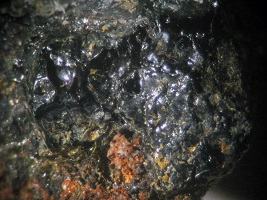
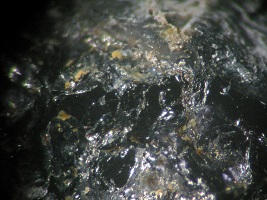
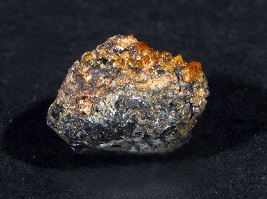
Confidence: 5
Chemistry: (Ce,Ca,Fe,Th)(Ti,Nb)(O,OH)6
Locality: Bald Mtn., Ossipee, NH
Specimen Size: About 3 mm field of view, top two photos. Lower photo shows overall specimen.
Field Collected: Bob Janules 12/92
Catalog No.: A Bob Janules specimen
Notes: This is the underside of a specimen with the nice monazite-(Ce) and black orthorhombic crystals. It has the conchoidal fracture shown in these photos. A Kerry Day EDS analysis of this mineral gave a result suggesting nioboaeschynite-(Ce).
A Fred Davis review of the weight percent oxides from a May 2018 polished grain EDS analysis (BC282) produced an Ercit plot * indicating this was an aeschynite species. Fred stated that the "data shows a dominance of Ce, so likely aeschynite-(Ce)." He further indicated there was insufficient niobium to be nioboaeschynite-(Ce). "Nioboaeschynite should have >40% Nb-oxide, and aeschynite 23~29%." This specimen analysis Nb weight percent oxide was 23%.
=====================================
* See article by T. S. Ercit: Canadian Mineralogist Vol. 43 pp. 1291 - 1303 (2005)
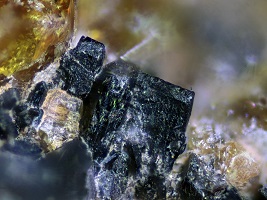
Locality: Bald Mtn. Ossipee, NH
Specimen Size: 1.2 mm field of view.
Field Collected: Bob Janules
Catalog No.: A Bob Janules specimen
Notes:
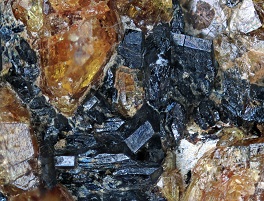
Locality: Bald Mtn. Ossipee, NH
Specimen Size: 2.6 mm field of view.
Field Collected: Bob Janules
Catalog No.: A Bob Janules specimen
Notes: Another view.
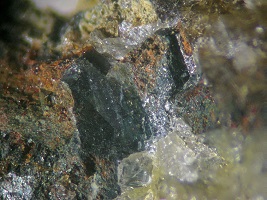
Confidence: 3
Chemistry: (Na,Ca)(Mn,Mg,Fe)(Fe,Mn)2(PO4)3
Locality: Palermo Mine, N. Groton, NH
Specimen Size: 3 mm field of view. Dark-green partially embedded crystals
Owner: Tom Mortimer
Field Collected: Clayton Ford. Gift from Gordon Jackson
Catalog No.: u2021
Analysis: A polished grain, standardless, quantitative EDS analysis (BC177) indicated a best fit of alluaudite.
The chemistry indicated by this analysis is: (Na)(Mn0.74,Mg0.35,Fe1.07)(PO4)2.25 plus excess O of 16, normalized for one Na. Note, excess oxygen has been frequently encountered with this EDS instrument.
Notes: Although alluaudite is not listed in Whitmore and Lawrence's The Pegmatite Mines Known as Palermo, there is a photo of alluaudite on the webmineral species page for a Palermo alluaudite: webmineral link.
Mindat's Palermo species list includes 'Alluaudite-Ferroalluaudite Series' but no photos. The mindat.org reference cited is the Min Rec 1973 phosphate article by P. Moore. Checking this article, P. Moore does not include alluaudite in the discussion of its localities, but does list Palermo in phosphate species locality tabulation under alluaudite. The MR's article description of alluaudite as "deep opaque dull green color" is very different from the webmineral photo. The Encyclopedia of Minerals includes Palermo in the alluaudite species list. It describes the "COLOR-LUSTER" of the alluaudite species as "dull greenish black, dirty yellow, brownish yellow to brownish black." Quite a range ... that would seem to include the webmineral specimen.
Dana's System of Mineralogy 7th edition, pg. 674, describes alluaudite as "Color dirty yellow to brownish yellow, also dull greenish black..."
An email from Jim Nizamoff provided the following insight:
"The alluaudite group … [is one of the] Palermo "problem children". [There are] a bunch of specimens floating around that are labeled "hagendorfite". Some may be an alluaudite group member and some are not even phosphate (dark siderite, etc.). If you look at the hagendorfite-(Na)(Na) gallery on Mindat, two of the three specimens are likely alluaudite. Another [photo] is almost surely a kryzhanovskite. Alluaudite usually shows a well developed cleavage on 001 which is a good indicator and also tends to form more blocky crystals than arrojadite or bjarebyite/kulanite. I don't think there is a ton of alluaudite at Palermo and it is probably restricted to a couple of the phosphate pods. For some reason most of the K and Na bearing early formed phosphates that I have observed tend to be in the arrojadite group even though alluaudite has a somewhat similar chemistry. Another reason that alluaudite has been semi-ignored is that it is more of a massive phosphate and doesn't typically form decent crystals. Perhaps if you are brave enough to search for this you may find that more is present than previously thought. The two pieces in your website photos look like reasonable possibilities but EDS may not be able to resolve this."
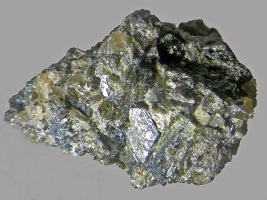
Locality: Palermo Mine, N. Groton, NH
Specimen Size: 1.8 cm specimen.
Field Collected: Janet Cares - 1976
Catalog No.: From Janet Cares TN collection. MMNE auctioned to Ray Meyers
Notes: Green is alluaudite. A polished grain, standardless, quantitative EDS analysis (BC311) indicated a reasonably good fit for alluaudite, (Na,Ca)(Mn,Mg,Fe)(Fe,Mn)2(PO4)3 .
The APFU computed from the atomic percents of analysis BC311 gives:
(Na0.92,Ca0.07)Σ=0.99(Mn0.41,Mg0.02,Fe0.57)Σ=1(Fe1.02,Mn0.44)Σ=1.46P3O5.4 normalized for 3 P atoms. In this computed chemistry, I [tm] have distributed the Fe and Mn to best fit the alluaudite formula.
A Raman analysis on the same BC311 polished grain indicated better matches with arrojadite group RUFF reference data.
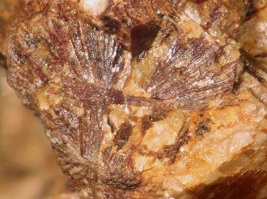
Confidence: 3
Chemistry: Ca2Fe3(AsO4)3O2 · 3H2O
Locality: Turner Mine, Walpole, NH
Specimen Size: 4 mm radiating group
Owner: Bob Wilken
Field Collected: Bob Wilken
Catalog No.: A Bob Wilken collection specimen and photo
Analysis: A polished grain, standardless, quantitative EDS analysis (TUR04) indicated a best fit of arseniosiderite.
The chemistry indicated by this analysis is: Ca4.62Fe2.27(AsO4)3O75 , normalized for 3 As.
This result is heavy on the Ca, and has lots of extra oxygen (an issue we frequently see on our analyses).
Minerals that include only Ca, Fe, As, O include Arseniosiderite, Barahonaite-(Fe), Kolfanite, Lazarenkoite, Sewardite, Walentaite, Wallkilldellite-(Fe), Yukonite
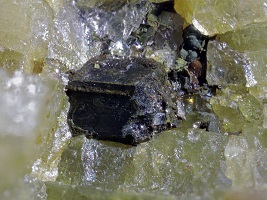
Locality: Turner Mine, Marlow, NH
Specimen Size: 1.5 mm broken crystal.
Field Collected: Bob Wilken - 11/20/20
Catalog No.: u2603
Notes: [bw] The blocky arseniosiderite was what I originally thought would be lollingite or arsenopyrite. I think you [tm] mentioned at some point Nizamoff thought it could be the walentaite. I've attached the two EDS probe results. I can see why he might have said that due to the presence of both As and P. However, there is no Mn. It seems the formula has gone through some revision..... Chemical formula revised from H2Ca2Fe3+6(AsO4)5(PO4)3·14H2O
to Fe3+(Ca,Mn2+,Fe2+,Na,[ ])(As3+3O6)(PO4)2(O,OH)(H2O)5: Grey I E, Mumme W G, Hochleitner R (2019) Trimeric As3+3O6 clusters in walentaite: crystal structure and revised formula.
European Journal of Mineralogy 31, 111-116, chemical formula changed from
Fe3+3(Ca,Mn2+,Fe2+,Na,[ ])(As2+3O6)(PO4)2(O,OH)(H2O)5 to [Mn(H2O)6][[ ]As3+3Fe+3(PO4)2O7]. The odd element out in the EDS result is S. It's in neither arseniosiderite or walentaite. Not sure what to make of that. I wonder if these are a pseudomorph of arsenopyrite having altered to arseniosiderite Ca2Fe3+3(AsO4)3O2 · 3H2O with some remaining S. Anyway, given the imperfections of mineral analysis, of the options, arseniosiderite was the best one. Barahonaite- Fe, Kolfanite, Lazarenkoite, Sewardite, Yukonite and Wllkildellite-Fe were the remaining choices if P and S were eliminated from the search. For this P would simply be a sub for As. I think it's the S that's at issue.
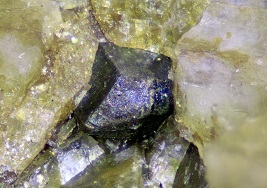
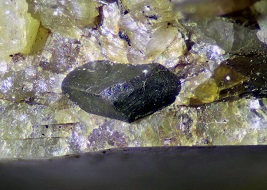
Locality: Turner Mine, Marlow, NH
Specimen Size: 1.2 mm crystal
Field Collected: Bob Wilken
Catalog No.: A Bob Wilken specimen and photos
Notes: EDS analyses and EDS analyses indicated arseniosiderite.
[bw] This is the one Nizamoff said could be walentaite. The issue ... is the question regarding how much As vs P is enough to tip the balance in favor of walentaite. Nizamoff said for .... walentaite P is commonly present in lesser amounts than As
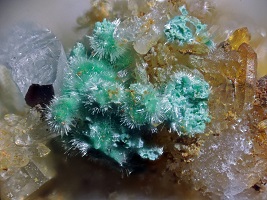
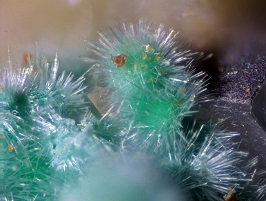
Locality: Stoddard Mine, Westmoreland, NH
Specimen Size: 3.2 mm field of view and 1.0 mm FOV close-up
Field Collected: Tom Mortimer
Catalog No.: u2659
Notes: Reviewing my lot of un-cataloged Stoddard malachite micros collected years ago, I found this. Visually, a good match for aurichalcite. A couple of typical Stoddard Mine micro barite crystals are also on this specimen.
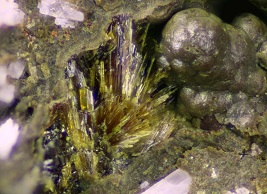
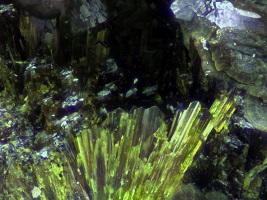
Locality: Turner Mine, Marlow, NH
Specimen Size: 1.5 mm mm field of view, top photo
Field Collected: Anna Wilken
Catalog No.: TUR-Bendadaite02. A Bob Wilken photo
Notes: Bob's visual ID on this was childrenite or whitmoreite. EDS testing showed this to be bendadaite, a new species for New Hampshire.
Bob Wilken published this find in the March, 2022 MMNE newsletter.
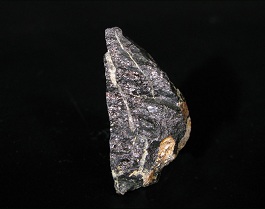
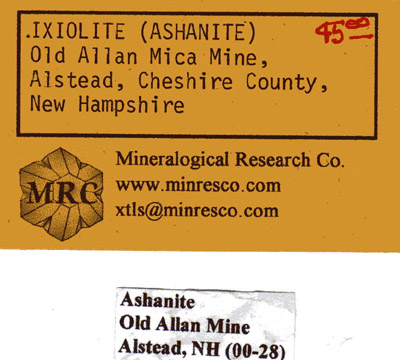
Confidence: 3
Chemistry: Moderate variation in the chemistry of this group - see mindat.org
Locality: Allen Mine, Alstead, NH
Specimen Size: 3 cm specimen
Owner: Tom Mortimer
Field Collected: Joe Lech. A purchased specimen
Catalog No.: 1660
Analysis: An EDS analysis performed on this specimen indicated a much better match for betafite than for ixiolite.
Notes: Specimen purchased from Mineralogical Research, San Jose, CA. The label that accompanied specimen is reproduced below the specimen photo.
Communication from Mineralogical Research stated that this specimen came from the collection of Joseph F. Lech, Jr.
Neither betafite, ashanite, nor ixiolite appears on historical NH species lists. Ashanite is very similar to Ixiolite except in Ashanite the Niobium content exceeds the Tantalum content. The EDS analyist stated "The best fit is BETAFITE. Under the beam very heavy elements like Uranium throw off high energy electrons which interact with the metals of the SEM chamber. The Al, Si and Cu peaks are probably from the metals inside the SEM chamber. Definitely not Ixiolite."
Follow-up research on the provenance of this specimen has determined it was field collected by Joe Lech, subsequently sold to Tony Albini, who then sold it to Mineralogical Research. The Ashanite/Ixiolite identification was not made by Joe Lech, (personel communication).
Per note on mindat: Ashanite was "Originally thought to be the Nb-dominant analogue of Ixiolite, the type material is now believed to be a mixture of several minerals including Ixiolite, Samarskite-(Y) and Uranmicrolite."
A 2018 polished grain EDS analysis (weight percent oxide) gave a result of columbite-(Mn)/columbite-(Fe). This suggests there is a fair amount of compositional variation in this specimen.
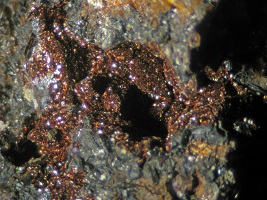
Confidence: 3
Chemistry: (Mn2+,Fe2+,Ca,Mg)3+(PO4)2
Locality: Palermo Mine, N. Groton, NH
Specimen Size: 10 mm field of view. Nut brown scales of beusite? on black siderite.
Owner: Tom Mortimer
Field Collected: Walter Lane
Catalog No.: u1463
Notes: A gift from Gene Bearss. Beusite has not previously been reported from the Palermo Mine, or the state of New Hampshire. This specimen was labeled by Gene as lepidocrocite, which is a reasonable visual idenitifcation. Lepidocrocite is a simple iron oxide, dimorphous with goethite. However, a qualitative EDS analysis suggested beusite was the best fit, (no Fe, but lots of Ca, P, and Mn).
Robertsite would seem to be another possibility, Ca3Mn3+4(PO4)3O2·3H2O
It is impossible to photograph these tiny, lustrous, randomly-oriented, scales without getting at least a few bright reflections.
Jim Nizamoff suggested bermanite for this mineral. However, bermanite does not contain calcium, and there is a lot of calcium indicated by the EDS analysis.

Confidence: 4
Chemistry: Pb46Bi54S127 (Fleischer 2008)
Locality: Aggregate Industries Quarry, Raymond, NH
Specimen Size: 3.5 mm field of view
Field Collected (owner): Tom Mortimer
Catalog No.:
Analysis: A January, 2014 EDS analysis of these metalic needles indicated this is a lead-bismuth mineral. The chemistry of the metalic needles and the ribbons appears to be identical.
Another mineralogist reviewing the spectra of our recently analyzed "Pb-Bi alloy" mineral has suggested that the Pb-Bi peaks in the 2.3 to 2.4 KeV region may be masking sulfur lines in this region, this suggesting a Pb-Bi sulfide mineral.
A February, 2014 EDS analysis of these metalic ribbons (from a Tom Mortimer specimen) indicated this is a lead-bismuth mineral.
Tony Mariano performed two EDS analyses on these metalic ribbons: Cannizzarite1_EDS , Cannizzarite2_EDS.
Peter reported: "The metallic needles clearly are a Pb, Bi, S mineral. Tony says that there is noticeably more bismuth than lead. Of the possible Pb-Bi-S minerals only two: cannizzarite (monoclinic) and galenobismutite (orthorhombic) have more Bi than Pb. Tony likes cannizzarite, but we would need XRD or some other structural analysis to be sure. (There is a small amount of Cu in one analysis, which makes me also wonder about cosalite, but the Pb-Bi ratio is wrong.)"
Notes: Peter Cristofono suggested candidate species of (links to mindat photos):
Galenobismutite
Cosalite
Cannizzarite
Acknowledging the likelihood of Pb and Bi masking the sulfur lines, Kerry Day responded: "Since both metallic Bismuth and Bismuth alloys have a brittle fracture like sulfides there is no good way to tell if Sulfur is present. The Pb and Bi are subequal, therefore, of the possibilities you mentioned only Cannizzarite and Cosalite fit. I am not an expert on Pb-Bi sulfides but they do make more sense than naturally occurring Pb-Bi alloys."
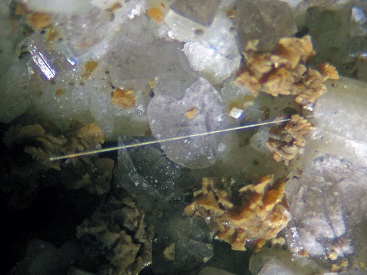
Locality: Aggregate Industries Quarry, Raymond, NH
Specimen Size: metalic needle is almost 1 cm long
Field Collected (owner): Tom Mortimer
Catalog No.:
Notes:
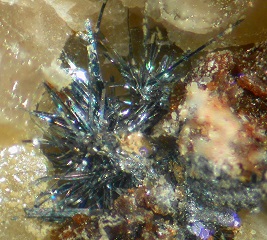
Locality: Aggregate Industries Quarry, Raymond, NH
Specimen Size: 2 mm field of view
Field Collected (owner): Bob Wilken
Catalog No.:
Notes:
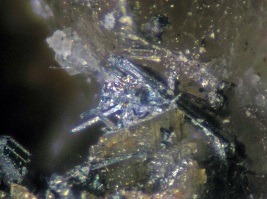
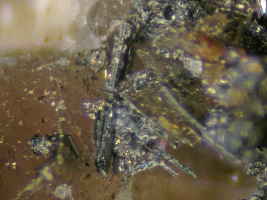
Locality: Aggregate Industries Quarry, Raymond, NH
Specimen Size: 1 mm field of view. Two photos, different lighting & orientation.
Field Collected (owner): Tom Mortimer
Catalog No.:
Notes:
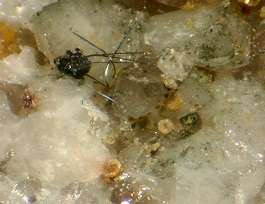
Locality: Aggregate Industries Quarry, Raymond, NH
Specimen Size: 0.7 mm wire assemblage
Field Collected (owner): Bob Wilken
Catalog No.:
Notes: [BW] I looked at the wires a long time before I saw the discs!
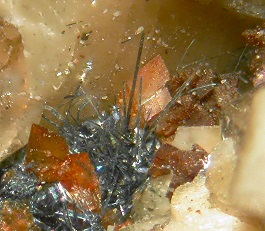
Locality: Aggregate Industries Quarry, Raymond, NH
Specimen Size: The long lath as best as I can measure is 1.5 mm long
Field Collected (owner): Bob Wilken
Catalog No.:
Notes: [BW] Depending upon how the lighting hits the blades they can exhibit a blue appearance. Perhaps just optics or a superficial oxidation?
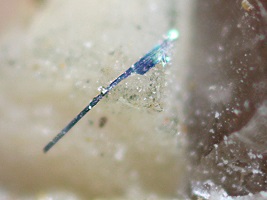
Locality: Aggregate Industries Quarry, Raymond, NH
Specimen Size: Metallic blue, curved "ribbon." (about 2.5 - 3 mm long).
Field Collected (owner): Peter Cristofono
Catalog No.:
Notes:
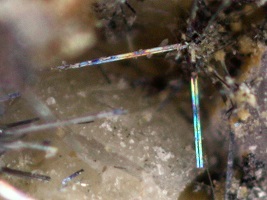
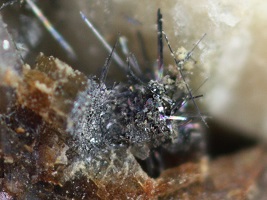
Locality: Aggregate Industries Quarry, Raymond, NH
Specimen Size: Metallic blue "ribbon." TBD FOV.
Field Collected (owner): Peter Cristofono
Catalog No.:
Notes:
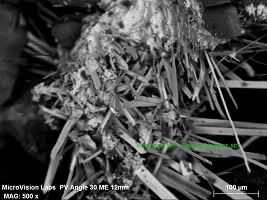
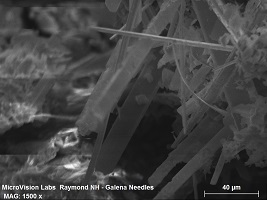
Locality: Aggregate Industries Quarry, Raymond, NH
Specimen Size: Tony Mariano SEM photo. FOV indicated by scale
Field Collected (owner): Peter Cristofono
Catalog No.:
Notes:

Locality: AI Quarry, Raymond, NH
Specimen Size: Cannizzarite ribbon, 1.6 mm, draped from albite crystal (left) to over top of siderite crystal (right).
Field Collected: Tom Mortimer
Catalog No.: u2340
Notes: From a stack of 68 images.
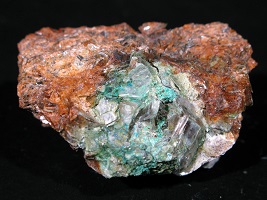
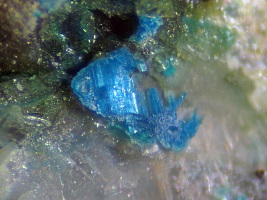
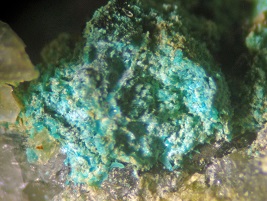
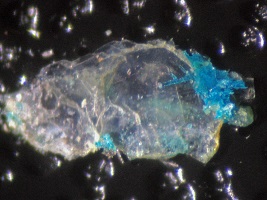
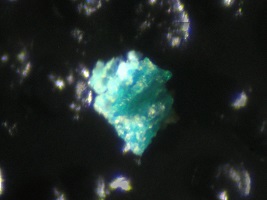
Confidence: 1
Chemistry: CuSO4 · 5H2O
Locality: Palermo Mine, N. Groton, NH
Specimen Size: 4.3 cm specimen with close-up view sizes indicated in photos
Owner: Tom Mortimer. A gift from Dana Jewel, 2015.
Field Collected: Dana Jewel
Catalog No.: u1788
Analysis: Carbon tape mounted grain EDS analyses of both the blue and blue-green minerals (4th and 5th photos) suggested a copper sulfate species on a mica substrate, (the source of the Si, Al, and K in the EDS plots). (The pulse counts for these analyses are quite low, but the best data I curently have.) Chalcanthite is likely the most common of the copper sulfates, but there about ten others. Phosphorous not detected, so not pseudomalachite.
Notes: Bob Whitmore's book, The Pegmatite Mines Known as Palermo does not include any copper sulfate species, so this could be a new one for Palermo.
As the red-brown staining is sometimes indicative of the presence of uranium minerals, the specimen was checked with a scintillometer. No radiation was detected. No fluorescence was observed with SW or LW UV.
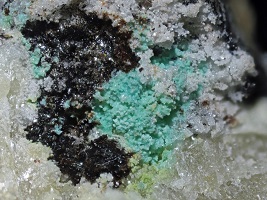
Locality: Palermo Mine, Groton, NH
Specimen Size: 4 mm field of view
Field Collected: Forrest Fogg material - from unsorted box of small chunks
Catalog No.: TBC
Notes: Grain pushed into drop of muriatic acid disolved slowly with a few bubbles. Smithsonite and aurichalcite might also be considered here. The black, granular, mineral adjacent to the blue-green mineral is unidentified. Aurichalcite is not reported from Palermo. Milky hexagonal apatite crystals, fluorescent orange in LW UV, are most of the matrix.
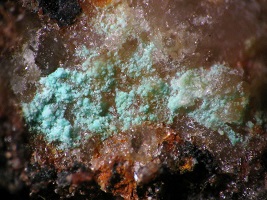
Confidence: 2
Locality: Johnson Rd., Bow, NH
Specimen Size: 4 mm field of view
Owner: Tom Mortimer. A gift from Jim Cahoon, 2017.
Field Collected: 2017
Catalog No.: u2083
Notes: Overall 1.4 cm specimen has some sphalerite and hydrozincite.
Wet tests: A tiny second zone on the matrix did not dissolve or appear to alter when a drop of water was added. Chalcanthite is water soluable. When a drop of muriatic was added, the mineral disolved. No fizz was observed (under my scope), but the area was very small. No colored residue was seen after the muriatic evaporated.
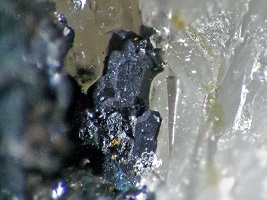
Confidence: 2
Chemistry: Cu2S
Locality: Johnson Rd. Locality, Bow, NH
Specimen Size: Largest crystal, center, 0.3 mm
Field Collected: From vein samples collected by Jim Cahoon. Micro found by Tom Mortimer - 10/18
Catalog No.: u2209
Notes: Chalcocite is a best guess based on environment and proximity to some covellite. Chalcocite has not been previously reported from New Hampshire.
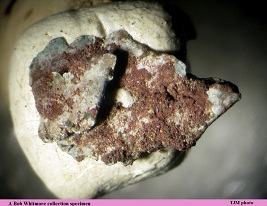
Confidence: 2
Chemistry: Cu
Locality: Milan Zinc Mine, Milan, NH
Specimen Size: 11 mm specimen on white mineral tac
Field Collected: Bob Whitmore - 2011
Owner: A Bob Whitmore specimen - Likely since sold.
Notes: The cream-colored substrate matrix for the native copper is soft, somewhat waxy. I confess to having some reservations about this specimen, perhaps due to my unfamilarity with other New England native copper specimens. Native copper has been on some early NH mineral species lists. [TM] This is the only New Hampshire native copper specimen I have seen.

Confidence: 2
Locality: Aggregate Industries Quarry, Raymond, NH
Specimen Size: 0.5 mm knotted wire
Field Collected (owner): Bob Wilken
Catalog No.:
Notes:
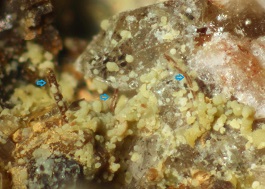
Confidence: 2
Locality: Aggregate Industries Quarry, Raymond, NH
Specimen Size: 1.8 mm FOV
Field Collected (owner): Bob Wilken
Catalog No.:
Notes: Three wires.